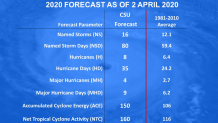
With the growing realization that we’ve only just begun to feel the pain of the novel coronavirus pandemic, the last thing anyone wants to think about is a hurricane.
But the Atlantic season begins in less than two months, and some of the seasonal forecasts for how active it may be are starting to be released. That includes the projection from the outfit where it all started – Colorado State University.
The forecast for 2020 calls for an active season, with 16 named tropical storms, 8 of them becoming hurricanes, and four of those reaching the destructive "major" hurricane category. Compared to normal, it would be a season with 50% more cyclonic power – based on the Accumulated Cyclone Energy index.

Dr. Phil Klotzbach is now in charge of the lab where Dr. William Gray, now deceased, first started writing the hurricane season forecasts decades ago. Klotzbach attributes the ominous projected increase in Atlantic storms to the absence of the El Niño phenomenon and the potential development of a La Niña as we get closer to the peak of the season in September.
El Niño usually results in stronger wind shear that can tear fledgling storms apart. La Niña produces the opposite effect, which can facilitate the strengthening process for tropical systems in the Atlantic.
Sea surface temperatures are warmer than normal across the tropical Atlantic, and super warm in the subtropical Atlantic. Should that hold into summer and early fall, that could also lead to more and stronger hurricanes.
Local
Two dozen entities – from academic institutions to commercial weather firms – throw their hat into the seasonal hurricane prediction ring every year. The handful of forecasts that have been released for 2020 concur that the season will be more active than an average year.
The U.S.’s National Oceanic and Atmospheric Administration will release their forecast in late May.



